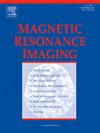基于磁场探头的不规则体积型感应耦合无线MRI射频线圈联合仿真方法。
IF 2.1
4区 医学
Q2 RADIOLOGY, NUCLEAR MEDICINE & MEDICAL IMAGING
引用次数: 0
摘要
背景:电感耦合无线线圈由于其成本效益和简单性而越来越多地用于MRI,从而消除了对前置放大器、平衡器、线圈插头和线圈ID电路等昂贵组件的需求。现有的预测元件值和电磁(EM)场的工具主要是为圆柱形体积线圈设计的,这使得它们不适用于不规则体积型无线线圈。目的:本研究的目的是介绍并验证一种基于磁场探头的新型联合仿真方法,以准确预测不规则体积型无线线圈的电容值和电磁场,从而解决现有预测工具的局限性。方法:提出的方法包括几个关键步骤:在电磁仿真软件中对线圈进行建模,用50个-Ω端口替换集总组件,在无线线圈中放置解耦良好的双拾取探针,进行全波电磁仿真,并将s参数矩阵导出到射频电路仿真工具中进行优化。射频电路仿真通过最大化双探头的Sxy平方根的平均幅度(mean_√Sxy)和最小化√Sxy的归一化标准差(normStd_√Sxy)来优化元件值。优化后的电容值通过重新进行EM模拟验证,硬件原型制作并在MRI实验中进行了测试。结果:采用为1.5 T MRI设计的瓶形和圆顶形Litzcage线圈对方法进行了验证。在不同线圈设计中观察到一致的谐振峰和磁场分布。通过电磁仿真验证了电路级仿真得到的优化电容值。在MRI实验中观察到显著的信噪比增强,与单独的身体线圈相比,无线手和手腕/头部线圈在EM模拟中显示出12.8/3.4倍的整体信噪比增强,在MRI实验中显示出13.4/3.8倍的整体信噪比增强。结论:基于h场探针的联合仿真方法为MRI不规则无线射频线圈的设计和优化提供了高效、准确的解决方案。通过集成电磁仿真、h场探头和射频电路优化,该方法减少了对广泛的全波电磁仿真的需求,并准确地预测了电容值和电磁场。使用不规则Litzcage线圈的验证证明了该方法的有效性,有助于提高MRI应用中的成像质量。这种方法为线圈开发人员和研究人员提供了一个有价值的工具,促进了高质量不规则无线线圈的开发,以增强MRI性能。本文章由计算机程序翻译,如有差异,请以英文原文为准。
Magnetic field probe-based co-simulation method for irregular volume-type inductively coupled wireless MRI radiofrequency coils
Background
Inductively coupled wireless coils are increasingly used in MRI due to their cost-effectiveness and simplicity, eliminating the need for expensive components like preamplifiers, baluns, coil plugs, and coil ID circuits. Existing tools for predicting component values and electromagnetic (EM) fields are primarily designed for cylindrical volume coils, making them inadequate for irregular volume-type wireless coils.
Purpose
The aim of this study is to introduce and validate a novel magnetic (H-) field probe-based co-simulation method to accurately predict capacitance values and EM fields for irregular volume-type wireless coils, thereby addressing the limitations of current prediction tools.
Methods
The proposed method involves several key steps: modeling the coil in EM simulation software, replacing lumped components with 50-Ω ports, placing well-decoupled double pick-up sniffer probes within the wireless coil, conducting full-wave EM simulations, and exporting the S-parameter matrix to an RF circuit simulation tool for optimization. The RF circuit simulation optimizes component values by maximizing the average magnitude of the root square of Sxys (mean_√Sxy) of double probes and minimizing the normalized standard deviation of √Sxy (normStd_√Sxy). The optimized capacitance values are validated through re-performing EM simulations, and hardware prototypes are fabricated and tested in MRI experiments.
Results
The method was validated using bottle-shaped and dome-shaped Litzcage coils designed for 1.5 T MRI. Consistent resonant peaks and magnetic field distributions were observed across different coil designs. The optimized capacitance values obtained from circuit-level simulations were confirmed through EM simulations. Significant SNR enhancements were observed in MRI experiments, with the wireless hand and wrist/head coil showing an overall SNR enhancement of 12.8/3.4-fold in EM simulation and 13.4/3.8-fold in MRI experiments, compared to the body coil alone.
Conclusions
The H-field probe-based co-simulation method provides an efficient and accurate solution for designing and optimizing irregular wireless RF coils in MRI. By integrating EM simulation, H-field probes, and RF circuit optimization, this method reduces the need for extensive full-wave EM simulations and accurately predicts capacitance values and EM fields. The validation using irregular Litzcage coils demonstrated the method's efficacy, contributing to improved imaging quality in MRI applications. This approach offers a valuable tool for coil developers and researchers, facilitating the development of high-quality irregular wireless coils for enhanced MRI performance.
求助全文
通过发布文献求助,成功后即可免费获取论文全文。
去求助
来源期刊

Magnetic resonance imaging
医学-核医学
CiteScore
4.70
自引率
4.00%
发文量
194
审稿时长
83 days
期刊介绍:
Magnetic Resonance Imaging (MRI) is the first international multidisciplinary journal encompassing physical, life, and clinical science investigations as they relate to the development and use of magnetic resonance imaging. MRI is dedicated to both basic research, technological innovation and applications, providing a single forum for communication among radiologists, physicists, chemists, biochemists, biologists, engineers, internists, pathologists, physiologists, computer scientists, and mathematicians.
 求助内容:
求助内容: 应助结果提醒方式:
应助结果提醒方式:


